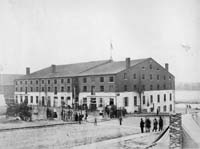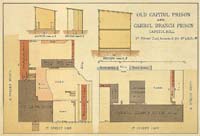Colonial Wars |
American Wars |
Link To This Page — Contact Us —
Old Capitol Prisoner of War Camp
Search, View, Print Union & Confederate Civil War Prisoner of War Records, 1861-1865
After the British burned the U.S. Capitol during the War of 1812, Congress built a brick building on 1st St. in Washington to serve as a temporary capitol. The building became known as the Old Capitol after Congress moved back to its permanent home, and it began a new life as a fashionable boardinghouse. Sen. John C. Calhoun was one of the many congressmen who lived there while in Washington, and in his old age, he became a close companion of the teenage niece of the proprietor of the boardinghouse. The young lady, Rose O'Neal, who also lived in the boardinghouse, became thoroughly indoctrinated by Calhoun in his theories on states' rights and secession and was forever loyal to Southern interests.
When the Civil War began, the Old Capitol in Washington, was abandoned and dilapidated. The government removed the high board fence surrounding the building, replaced the wooden slats nailed over the windows with iron bars, and turned it into a prison. The Old Capitol Prison was located on the present site of the U.S. Supreme Court building. The prison was also called the "American Bastille".
Security was provided mainly by guards who constantly paced around the outside. Many prominent prisoners were confined in the Old Capitol Prison, including Confederate generals, Northern political prisoners, blockade runners, and spies. Henry Wirz, commandant of Andersonville Prison, was hanged on the gallows in the yard of the Old Capitol Prison.
On February 28, 1862, Company A, 91st Pennsylvania Regiment, was assigned as prison guards to the Old Capitol Prison. But on May 4, 1862, Company E, 91st, was ordered to report to the Old Capitol Prison with 4 days cooked rations and all their camp equippage to take over guard duties.
On the first floor, the entrance from First Street opened to a broad hallway, which was used as a guard room, occupied by the relief. The office was next, used by the superintendent, clerk, captain of the guard, and officer in command of the guard. Interviews with prisoners were held in the office, and prisoners were questioned, searched, admitted, and discharged there. Also on the first floor was 'a long and dirty' mess room.
The second floor had 5 rooms, numbers 14 through 18, which all opened onto a hallway. Number 16, which was the largest room (with 21 bunks), had a window directly above the entrance, and faced the east front of the capitol. Room 10 was on the third floor, on the north side of the building--the first window from the corner on First Street.
The yard was about 100 feet square, partly paved with bricks and cobblestones. On the side, extending to the gate from the wooden building with the sutler's shop, mess-room, and hospital (with steps leading to it from the prison yard), was a one-story stone building with the cook house, guard house, wash house. Behind that stone building were the wide trenches the prisoners used as sinks [which seems to mean latrines]. An adjoining row of houses, Duff Green's Row, was also used as a prison.
Some of the prison rules were as follows:
- the sentinels on each floor had a standing order that no more than 2 men were allowed to leave their rooms at a time
- two orders were announced on 15 February 1863:
- singing Rebel songs was prohibited.
- any prisoners signaling passers-by (e.g. by bowing) would be moved to the guard-house
- letters had to go to Provost Marshall
- no lights were permitted at night
- no one was permitted past the guardroom without an explicit pass from the provost marshal or the Secretary of War
- prisoners were permitted to purchase additional food
- prisoners were not permitted to communicate with each other
- if a fire occurred, prisoners must assemble in the prison yard
Because the Old Capitol Prison was not separated from the city, and citizens had access to the surrounding streets, which windows in the prison rooms overlooked, messages could conceivably be passed between prisoners and passers-by. The guards, therefore, questioned and sometimes arrested passers-by who acknowledged the prisoners in any way (for example, by bowing or waving), and prisoners were not allowed to react to passers-by.
Some of the most noted prisoners were the women spies. Belle Boyd, while confined here, yelled taunts at the guards and sang patriotic Confederate songs out her window. Rose O'Neal returned to the boardinghouse of her youth as the widow Rose Greenhow, the beautiful and seductive Washington socialite whose spying activities were important to the Confederate success at 1st Bull Run. During the five months Rose, along with her young daughter, was imprisoned there, she managed to continue her spying activities for the Confederacy.
On April 1, 1862, Jesse B Wharton, who was being held at the Old Capital Prison, dared a guard to shoot him (probably for violating a rule against being by the window). The corporal in charge ordered the guard to shoot him the next time, and he did. The guard and corporal were imprisoned in the Central Guard House for weeks.
Harry Stewart bribed a guard (about $70) to let him escape from a window. The sentry ordered 'halt' and shot him in the thigh. The prison surgeon amputated his leg, but he died shortly after. The guard was 'ordered before court-martial', but escaped punishment.
There were 4 escapes from the prison during the war. All of them occured during 1863. On Feb 9, Captain Wynne escaped 'by breaking out a panel of his door', Feb. 13, Capt Darling and George Adreon escaped by bribing sentinel, Feb. 25, one man escaped by rushing gate when delivery wagon entered yard, and on March 6, two Union soldiers escaped through cellar, one was caught.
There were claims that Union soldiers who were serving out sentences, held on the lower floor, usually in ball and chain, 'were constantly caught in the act of escape', and caused more trouble than the other prisoners. He also mentions that two Confederate officers had escaped, before the attempt by Harry Stewart.


